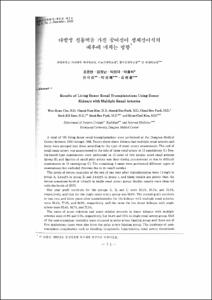다발성 신동맥을 가진 공여신이 생체신이식의 예후에 미치는 영향
- Alternative Author(s)
- Cho, Won Hyun; Park, Sung Dae; Park, Choal Hee; Zeon, Seok Kil; Park, Sung Bae; Kim, Hyun Chul
- Journal Title
- 대한이식학회지
- ISSN
- 1598-1711
- Issued Date
- 1992
- Abstract
- A total of 165 living donor renal transplantations were performed at the Dongsan Medical Center between 1982 through 1990. Fourty-three donor kidneys had multiple renal arteries and these were grouped into three according to the type of renal artery anastomosis; The end of small renal artery was anastomosed to the side of large renal artery in 13 cases(group A), Double-barrel type anastomoses were performed in 13 cases of two similar sized renal arteries (group B), and ligation of small polar artery was done during procurement or due to difficult anastomosis in 13 cases(group C). The remaining 4 cases were performed different types of anastomoses but excluded this time due to its small number.
The levels of serum creatinine at the end of one year after transplantation were 1.6 mg% in group A, 2.4 mg% in group B, and 3.4 mg% in group c, and these results are poorer than the serum creatinine level of 1.5 mg% in single renal artery group. Similar results were observed with the levels of BUN.
One year graft survivals for the groups A, B, and C were 92.3%, 93.3%, and 75.0%, respectively, and that for the single renal artery group was 93.4%. The overall graft survivals at one, two, and three years after transplantation for the kidneys with multiple renal arteries, were 88.4%, 77.3%, and 64.9%, respectively, and the same for the donor kidneys with single artery were 93.4%, 84.7%, and 72.6%.
The rates of acute rejection and acute tubular necrosis in donor kidneys with multiple arteries were 41.9% and 2.3%, respectively, but 34.4% and 2.5% in single renal artery group. Half of the post-transplant mortality were occurred in polar artery ligating group and three out of five grafectomy cases were also from the polar artery ligating group. The incidence of post-transplant complication such as bleeding, lymphocele, hypertension, renal artery thrombosis and urinary fistula were nearly the same.
From these results, authors conclude that donor kidneys with multiple renal arteries can be used without significant difference in graft function, complication and survival, but the liga-tion of polar artery should be avoid if all possible.
1982년부터 1990년 12월까지 계명대학교 동산병원에서 시행한 165예의 생체간 신이식환자중 다발성 신동맥을 가진 공여신을 이식받은 43예를 분석하여 이들의 이식후 경과 및 이식성적을 단일 신동맥군과 비교하였다.
43예의 다발성 신동맥공여신중 2예는 두개의 신동맥을 내장골동맥의 두개의 분지에 각각 단단문합했고, 다른 2예는 두개의 동맥을 총장골동맥에 단측문합, 내 장골동맥에 단단문합했다. 나머지 39예중 13예는 미세한 신동맥을 굵은쪽 신동맥에 단측문합했으며(제 1 군), 다른 13예는 두개의 신동맥끝을 쾌기형으로 절제 한후 서로 문합하여 하나의 혈관으로 만들었고(제 2 군)남온 13예는 여러가지 원인으로 신극동맥을 결찰했다(제3군이들 문합방법에 따른 이식후 1년째의 혈청 크레아치닌치는 1, 2, 3군 각각 1.6mg%, 2.4mg%, 3.4mg%, 28mg%로서 단일신동맥군 20mg%보다 높았다. 이식신의 생존율은 다발성 신동맥군의 경우 1, 2, 3년에 각각 88.4%, 77.3%, 64.9%로서 단일 신동맥군 93.4%, 84. 7%, 72.6%보다 낮았다.
이식후 발생한 급성거부반응의 빈도는 다발성신동맥군이 41.9%에서 병발해서 단일 신동맥군의 34.4%보다 잦았으나, 급성세뇨관괴사의 빈도는 각각 2.3%, 2.5%였다. 기타 다발성 신동맥군에 많을 것으로 예상 되었던 수술부위 출혈이나 임파종, 고혈압의 속발, 신동맥혈전, 뇨루등의 발생빈도는 양군 모두 비슷하였다.
다발성신동맥군 43예중에서 6예가 사망하였고 이중 3예가 신극동맥 결찰군이었고, 이식신을 절제했던 5예 중 3예가 다발성 신동맥군이었으며 이중 2예가 신극동맥결찰군이었다. 신기능이 악화되어 다시 투석요법을 시작한 환자의 숫자는 단일 신동맥군에서 더 많았으나 다발성신동맥군은 빨리 기능이 나빠져서 이식후 투석으로 전환한 기간이 짧은 것올 알 수 있었다.
이상의 결과로 생체사이의 신이식의 경우 다발성신 동맥을 가진 공여자라도 이들 신동맥의 문합만 잘 이루어 지면 이식후 경과나 신기능에 큰 문제가 없으므로 공여자군에서 제외시킬 이유가 없었다. 다만 다발성 동맥중 작은 동맥이라도 문합치 않고 결찰하는 것은 피하는 것이 이식후 사망율이나 이식신 제거율을 줄이고 이식성적을 향상시키는 방법이 되겠다.
- Alternative Title
- Results of Living Donor Renal Transplatations Using Donor Kidneys with Multiple Renal Arteries
- Department
- Dept. of Surgery (외과학)
Dept. of Urology (비뇨의학)
Dept. of Nuclear Medicine (핵의학)
Dept. of Internal Medicine (내과학)
- Publisher
- School of Medicine
- Citation
- 조원현 et al. (1992). 다발성 신동맥을 가진 공여신이 생체신이식의 예후에 미치는 영향. 대한이식학회지, 6(1), 75–83.
- Type
- Article
- ISSN
- 1598-1711
- 파일 목록
-
-
Download
 oak-bbb-03252.pdf
기타 데이터 / 1.47 MB / Adobe PDF
oak-bbb-03252.pdf
기타 데이터 / 1.47 MB / Adobe PDF
-
Items in Repository are protected by copyright, with all rights reserved, unless otherwise indicated.